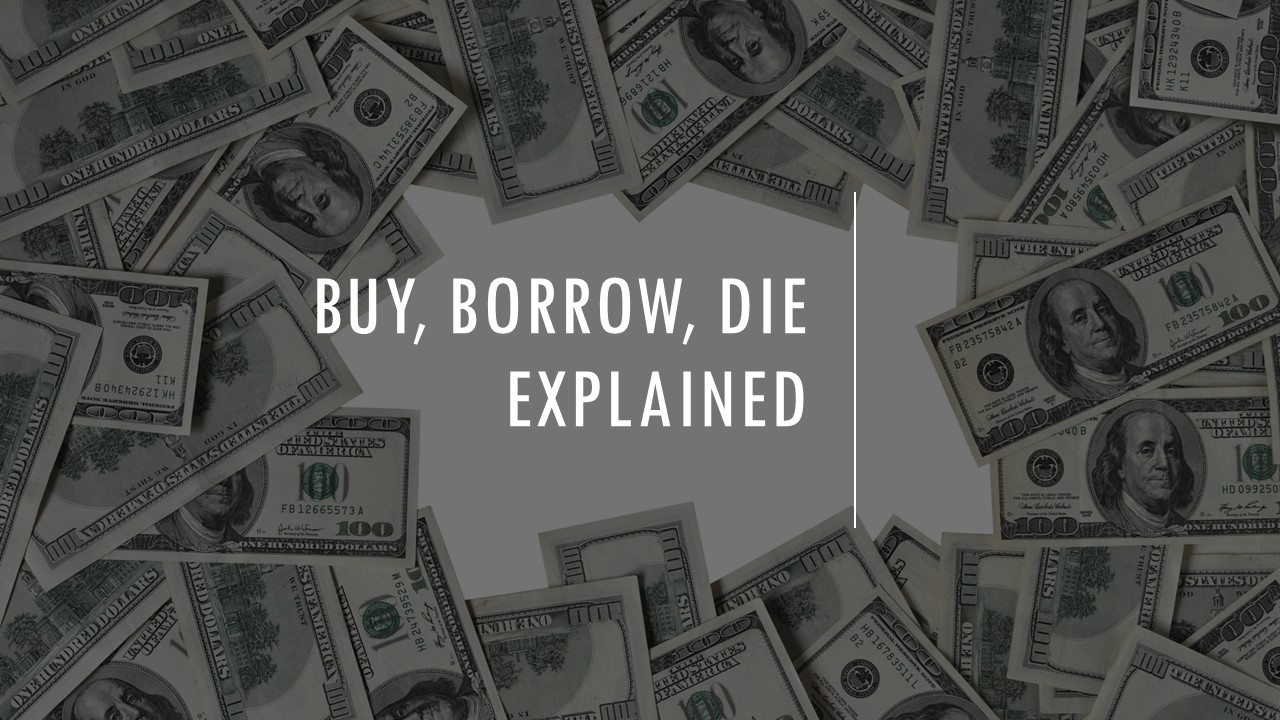
04 Sep Buy, Borrow, Die – How Emulating the Ultra-wealthy Can Make You Much Wealthier
In America, there are two tax systems: one for the informed and one for the uninformed. Both are legal.
– Judge Learned Hand
Many American adults spend more time planning for their vacation than planning for their wealth. The average person does not think about debt the way a billionaire thinks about it. The wealthy engage in different behaviors with regard to money than the average person, and therefore the wealthy achieve different results. If you want to build much more wealth, then emulating the ultra-wealthy is exactly what can help you close the gap between where you are and where you want to be.
The ultra-wealthy spend time researching types of assets, the tax code, and strategies that work. They follow a simple strategy that has been around for well over a century. They acquire assets. These assets appreciate in value over time, and some assets produce income like rent or dividends. Then they borrow money against their assets, and they use that money for their lifestyle and to acquire – you guessed it – more assets!
If the asset purchased with the loan appreciates faster than the interest rate on the loan, then they come out ahead. Imagine that an investor owns a rental property worth $400,000. They decide to conduct a 75% Loan to Value cash-out refinance, and they receive approximately $300,000 at a fixed interest rate of 6%. They take that $300,000 and buy a fixer-upper for $250,000. They spend the remaining $50,000 on renovations, and the second property is now worth $400,000. They rent out that second house. So the investor now has two houses producing positive cash flow. Both houses are appreciating in value faster than the 6% loan. The principal balance on the 6% loan is being paid down by the tenant residing in the first house. The investor claims depreciation on both houses, and they can deduct operating expenses and mortgage interest to lower their taxable income. Whereas the investor had a $400,000 property before, they now have $800,000 worth of real estate with only a $300,000 loan. They have increased their net worth and their cash flow by intelligently using debt. They might as well take out a loan on the second property to buy a third one!
It is a basic concept of the tax code that you pay taxes when you sell something for a profit. You don’t pay taxes on borrowed money. Most well-selected assets appreciate over time, and some go up exponentially in value. When you die, you leave the assets for your heirs. Your beneficiaries can, if they wish, sell those appreciated assets tax-free. Depending on how the debts are structured, the debts would be paid off by the estate or upon the sale of the assets by the heirs.
Below are the three basic steps of Buy, Borrow, Die:
Step 1: Buy assets that appreciate in value, such as:
- Real estate, particularly rental properties or land.
- Stocks.
- Businesses.
- Cryptocurrency.
The idea is to hold the assets and not sell during your lifetime. If you own an asset that goes up in value and you sell it, you have to pay capital gains taxes. If you owned something for a year or less, your tax is based on your ordinary income tax rate. If you owned an asset for more than a year, then your capital gains tax is 15% (20% for high income earners). As mentioned, your heirs could sell the assets they receive without paying capital gains tax on any of the appreciation that occurred in your lifetime. (If you have a compelling reason to sell some real estate, you can buy another property using a 1031 tax-deferred like-kind exchange. You can indefinitely defer paying capital gains taxes with a 1031 exchange. Read this for more information on 1031 exchanges.)
Step 2: Borrow money that is secured by the value of the assets, such as:
- Mortgage loans or HELOCs (Home Equity Line of Credit).
- Business loans.
- Portfolio loans.
- A pledged asset line or securities-backed line of credit against your stocks.
You live off of the borrowed money, and better yet, you buy more assets with that money. If you own rental properties, you also live off of the income. The tax on that income is reduced by the mortgage interest, depreciation, and operating expenses. If you own dividend-paying stocks, you can live off of the dividends. This strategy of holding and borrowing accelerates your ability to buy more assets. With more assets, you build more wealth as they grow in value. Then you can borrow more money, and the cycle repeats.
Step 3: Hold the assets and pass them on at a stepped-up tax basis to your heirs when you die.
We all have to die sometime, and that needs to be factored into a person’s wealth planning. In most cases, it would be silly for a wealthy person to sell their assets prior to their death since they would owe a tremendous amount in capital gains taxes. Their wealth would be reduced, and when they die there would be less to pass on to the heirs.
Let’s say I bought a rental property for $200,000 (using a mortgage loan) and it is now worth $500,000. After many years, the tenants would have paid off the mortgage while I received the rental income. If I sell the house before I die I have to pay capital gains taxes on the $300,000 in profit. However, if I leave the house for my heir and they sell it for $500,000, then neither I nor they would have paid any taxes on it. And of course, if my heir immediately buys an asset with that $500,000, they can repeat the Buy, Borrow, Die strategy. This is how ultra-wealthy families minimize their taxes and keep wealth going for generations. It’s all legal!
With this strategy, a startup founder can monetize their ownership stake without losing control of their company by selling shares. A real estate investor can obtain fixed mortgage loans at low interest rates and acquire many more properties. Someone with a sizeable stock portfolio can buy more stock.
You do not have to be a billionaire to benefit from this strategy. For example, the average person could take out a loan against their home to buy a rental property in cash. Later on, they can obtain a loan against that rental property to buy another one. Remember that you’re borrowing money at low interest rates against assets to buy assets that appreciate faster than those rates. Hold these assets to avoid capital gains taxes while living off of the income. Ensure that you have a properly written Will to designate your beneficiaries and intentions.
I want you to grow your wealth. Have fun following this strategy!
Tai DeSa is a graduate of The Wharton School of the University of Pennsylvania. He became a full-time real estate investor in 2004 after serving in the U.S. Navy. Tai has made colossal mistakes in investing (and learned some things along the way). He has helped hundreds of homeowners avoid foreclosure through successful short sales. Check out Tai’s books on Amazon.com. Tai may be available for coaching and speaking engagements on a variety of real estate topics. Send an email to tai@investandtransform.com.






No Comments